Cats being poisoned. Cats being shot. Cats suffering in cruel leg hold traps for three days.
All this could soon be legal, under proposed Victorian legislation. Cats desperately need you to speak up to stop it.
The government’s plan
The Victorian government wants to class wild cats on government land as a ‘pest’ species, under the guise of ‘helping wildlife’.
The many problems with this
No scientific basis
There is no scientific evidence that random killing of cats in open areas reduces their numbers or helps wildlife. On the contrary, a Tasmanian study found that cat numbers increase.
This will very likely backfire for threatened species.
Costly and futile
Government departments will be sent on a costly and futile exercise of focusing on killing cats instead of helping threatened species.
Cruelty
Once an animal is classed as a pest species, ‘anything goes’. They will be killed with poison. They will be subjected to leg hold traps. Other animals – including people’s lost cats, possums and quolls – will likely suffer agonising injuries and deaths.
If you need a reminder of what a leg hold trap feels like, check out this video (no graphic images; it’s on a person’s hand).
Companion and community cats will be harmed
Members of the public will only hear ‘cats are a pest species.’ Cruelty, vilification and killing of pet cats will be even worse than it already is.
Cats and wildlife need you to speak up
We simply can’t let these laws come in. They are bad for wildlife, bad for cats and bad for taxpayers.
Can cats count on you to speak up for them?
Please speak up today. Comments close 11:59pm Sunday 20 May
Please speak up for cats and wildlife by making a submission opposing this.
What to say
Feel free to use these pointers as a guide. Use your own words. Remember that fact, rather than emotion, will be more helpful to cats and wildlife.
Unscientific
- The proposal is not based on science.
- Many studies have found that simply removing cats does not protect wildlife. Often, other species – both introduced and native – continue to have an impact. Habitat loss and disturbance through clearing and development, fire regimes and climate change affect a species’ ability to survive.
- Research has found that low level killing of cats in open areas increases, not decreases, their numbers (Lazenby et al 2014)
- Research also shows that 30-50% of cats will need to be killed every six months for at least 10 years to reduce numbers (Miller et al 2014). The government cannot achieve this, either financially or practically
- The government will focus on a KPI of dead cats rather than effective actions that will increase threatened species populations
- It is not a long-term solution to the challenges faced by threatened species, such as habitat loss and disturbance, fire regimes and climate change
Strong opposition by the RSPCA and community
- Last year, RSPCA Australia proposed this very thing in its cat discussion paper
- There was overwhelming opposition and the RSPCA no longer supports this. It states, “One of the consequences of labelling cats as…‘pests’ is the demonisation of cats as aggressive predators, leading to a lack of consideration for their welfare and, in the most extreme cases, deliberate inhumane treatment.”
- There are already ‘cat hate’ groups and individuals who justify horrific acts of cruelty to cats, including pet cats, under the guise of saving wildlife. This includes cats who are shot with bows and arrows, poisoned, drowned and tortured
- The RSPCA was not on the Victorian committee that developed this latest proposal
- Animal welfare is clearly not important to the government
- The proposed feral cat ‘code of practice’ has not been developed
Cruelty to wild cats
- Poison will be used to kill cats
- The government will no doubt make it legal for cats to languish in leg hold traps for three days, as it has allowed for dogs. This is barbaric
- The declaration indicates that ‘agents’, such as pest controllers and shooters, can legally kill cats. This will not protect animal welfare, as the fact sheet indicates
- Leg hold traps are opposed by the RSPCA
Cruelty to pet cats
- Cats are Australia’s second most popular companion animal
- However, cat haters will only hear ‘cats are pests’ and will harm people’s pets. They are already doing this
- The government is encouraging cruelty and illegal vigilante activities to kill people’s pets
- There will be no consequences to offenders, just as there are no consequences when protected wildlife are tortured and killed
‘Consultation’
- The government announced a start date, before consultation was completed
- The Minister proudly states that she supports the declaration
- The consultation period is a token exercise
- The government clearly intends to proceed with this scientifically-flawed policy, regardless of feedback
Conclusion
- I oppose this proposal
- It is not based on science. It will lead to government departments focusing on the wrong measure of success and will not protect threatened species. It will waste taxpayer money
- It will lead to further cruelty to all types of cats, including people’s family members
- I urge the government not to proceed
- I ask that it supports scientific research on effective strategies that assist threatened species and provide long-term, humane and non-lethal solutions, rather than ineffective killing of cats
Where to send your submission
Email biodiversity.regulation@delwp.vic.gov.au by 11:59pm Sunday 20 May.
References
Lazenby, B.T.; Mooney, N.J.; Dickman, C.R. (2015) Effects of low-level culling of feral cats in open populations: A case study from the forests of southern Tasmania. Wildlife Research, 41, 407-420
Miller PS, Boone JD, Briggs JR, Lawler DF, Levy JK, et al. (2014) Simulating Free-Roaming Cat Population Management Options in Open Demographic Environments. PLoS ONE 9(11): e113553. doi: 10.1371/journal.pone.0113553
